UPC2A is required for high-level azole antifungal resistance in Candida glabrata
- PMID: 24867980
- PMCID: PMC4136023
- DOI: 10.1128/AAC.02217-13
UPC2A is required for high-level azole antifungal resistance in Candida glabrata
Abstract
Candida glabrata, the second most common cause of Candida infections, is associated with high rates of mortality and often exhibits resistance to the azole class of antifungal agents. Upc2 and Ecm22 in Saccharomyces cerevisiae and Upc2 in Candida albicans are the transcriptional regulators of ERG11, the gene encoding the target of azoles in the ergosterol biosynthesis pathway. Recently two homologs for these transcription factors, UPC2A and UPC2B, were identified in C. glabrata. One of these, UPC2A, was shown to influence azole susceptibility. We hypothesized that due to the global role for Upc2 in sterol biosynthesis in S. cerevisiae and C. albicans, disruption of UPC2A would enhance the activity of fluconazole in both azole-susceptible dose-dependent (SDD) and -resistant C. glabrata clinical isolates. To test this hypothesis, we constructed mutants with disruptions in UPC2A and UPC2B alone and in combination in a matched pair of clinical azole-SDD and -resistant isolates. Disruption of UPC2A in both the SDD and resistant isolates resulted in increased susceptibility to sterol biosynthesis inhibitors, including a reduction in fluconazole MIC and minimum fungicidal concentration, enhanced azole activity by time-kill analysis, a decrease in ergosterol content, and downregulation of baseline and inducible expression of several sterol biosynthesis genes. Our results indicate that Upc2A is a key regulator of ergosterol biosynthesis and is essential for resistance to sterol biosynthesis inhibitors in C. glabrata. Therefore, the UPC2A pathway may represent a potential cotherapeutic target for enhancing azole activity against this organism.
Copyright © 2014, American Society for Microbiology. All Rights Reserved.
Figures
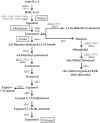
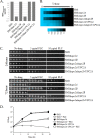
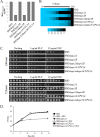

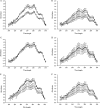
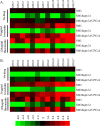
Similar articles
-
Loss-of-Function ROX1 Mutations Suppress the Fluconazole Susceptibility of upc2AΔ Mutation in Candida glabrata, Implicating Additional Positive Regulators of Ergosterol Biosynthesis.mSphere. 2021 Dec 22;6(6):e0083021. doi: 10.1128/msphere.00830-21. Epub 2021 Dec 22. mSphere. 2021. PMID: 34935446 Free PMC article.
-
Activity of Isavuconazole and Other Azoles against Candida Clinical Isolates and Yeast Model Systems with Known Azole Resistance Mechanisms.Antimicrob Agents Chemother. 2015 Oct 19;60(1):229-38. doi: 10.1128/AAC.02157-15. Print 2016 Jan. Antimicrob Agents Chemother. 2015. PMID: 26482310 Free PMC article.
-
The Candida glabrata Upc2A transcription factor is a global regulator of antifungal drug resistance pathways.PLoS Genet. 2021 Sep 30;17(9):e1009582. doi: 10.1371/journal.pgen.1009582. eCollection 2021 Sep. PLoS Genet. 2021. PMID: 34591857 Free PMC article.
-
[Azole resistance in Candida spp].Nihon Ishinkin Gakkai Zasshi. 2003;44(2):87-92. doi: 10.3314/jjmm.44.87. Nihon Ishinkin Gakkai Zasshi. 2003. PMID: 12748589 Review. Japanese.
-
Resistance in human pathogenic yeasts and filamentous fungi: prevalence, underlying molecular mechanisms and link to the use of antifungals in humans and the environment.Dan Med J. 2016 Oct;63(10):B5288. Dan Med J. 2016. PMID: 27697142 Review.
Cited by
-
Sterol uptake and sterol biosynthesis act coordinately to mediate antifungal resistance in Candida glabrata under azole and hypoxic stress.Mol Med Rep. 2018 May;17(5):6585-6597. doi: 10.3892/mmr.2018.8716. Epub 2018 Mar 9. Mol Med Rep. 2018. PMID: 29532896 Free PMC article.
-
The Microevolution of Antifungal Drug Resistance in Pathogenic Fungi.Microorganisms. 2023 Nov 13;11(11):2757. doi: 10.3390/microorganisms11112757. Microorganisms. 2023. PMID: 38004768 Free PMC article. Review.
-
Azole Resistance Reduces Susceptibility to the Tetrazole Antifungal VT-1161.Antimicrob Agents Chemother. 2018 Dec 21;63(1):e02114-18. doi: 10.1128/AAC.02114-18. Print 2019 Jan. Antimicrob Agents Chemother. 2018. PMID: 30397057 Free PMC article.
-
Overlapping coactivator function is required for transcriptional activation by the Candida glabrata Pdr1 transcription factor.Genetics. 2024 Sep 4;228(1):iyae115. doi: 10.1093/genetics/iyae115. Genetics. 2024. PMID: 39028831 Free PMC article.
-
Insights into the role of sterol metabolism in antifungal drug resistance: a mini-review.Front Microbiol. 2024 Oct 11;15:1409085. doi: 10.3389/fmicb.2024.1409085. eCollection 2024. Front Microbiol. 2024. PMID: 39464401 Free PMC article. Review.
References
-
- Odds FC. 1988. Candida and candidosis: a review and bibliography, 2nd ed. Bailliere Tindall, London, United Kingdom
-
- Ostrosky-Zeichner L, Rex JH, Pappas PG, Hamill RJ, Larsen RA, Horowitz HW, Powderly WG, Hyslop N, Kauffman CA, Cleary J, Mangino JE, Lee J. 2003. Antifungal susceptibility survey of 2,000 bloodstream Candida isolates in the United States. Antimicrob. Agents Chemother. 47:3149–3154. 10.1128/AAC.47.10.3149-3154.2003 - DOI - PMC - PubMed
-
- Pfaller MA, Messer SA, Hollis RJ, Jones RN, Doern GV, Brandt ME, Hajjeh RA. 1999. Trends in species distribution and susceptibility to fluconazole among blood stream isolates of Candida species in the United States. Diagn. Microbiol. Infect. Dis. 33:217–222. 10.1016/S0732-8893(98)00160-6 - DOI - PubMed
Publication types
MeSH terms
Substances
Grants and funding
LinkOut - more resources
Full Text Sources
Other Literature Sources
Molecular Biology Databases

